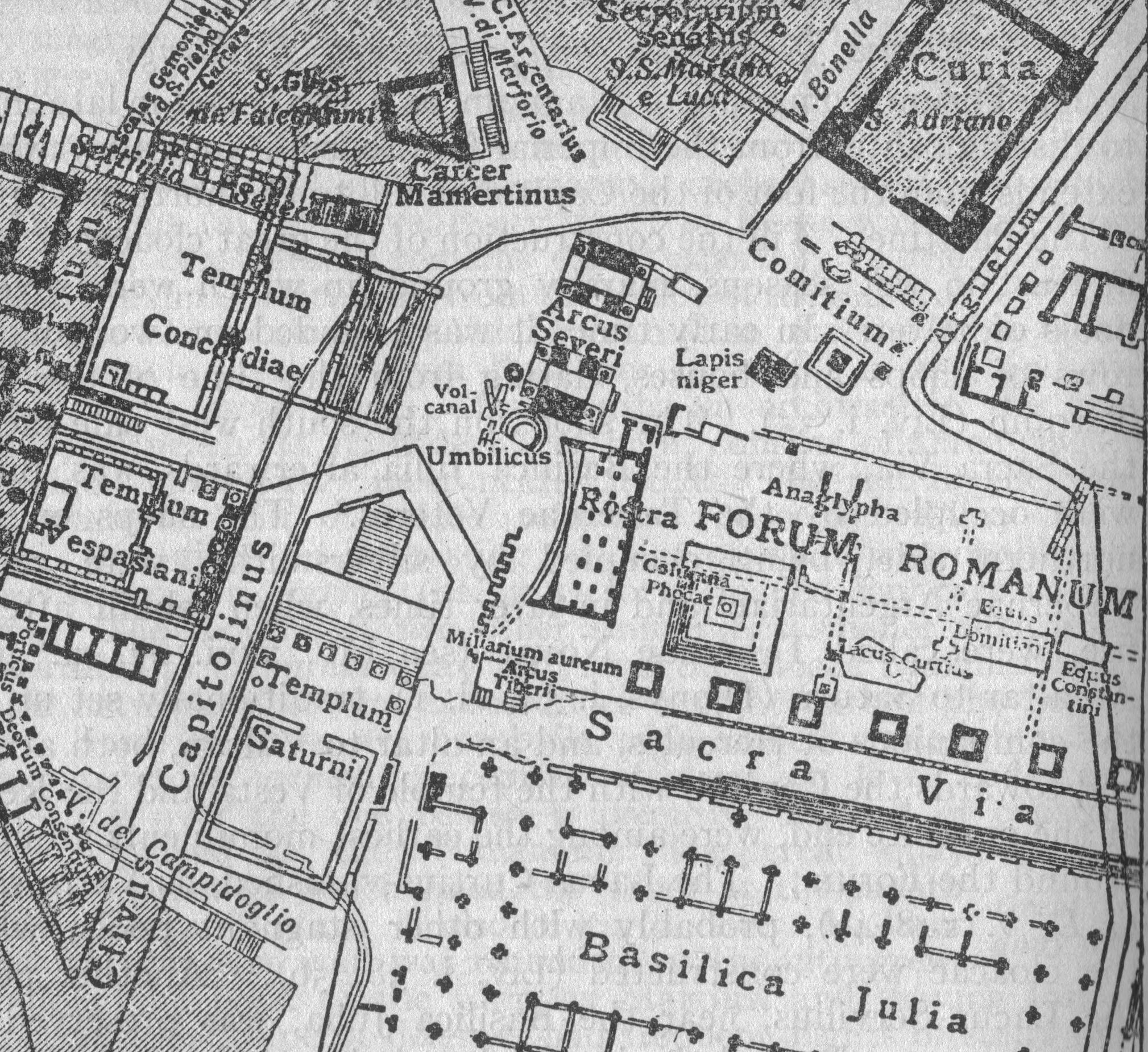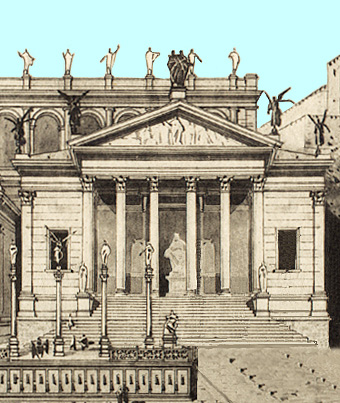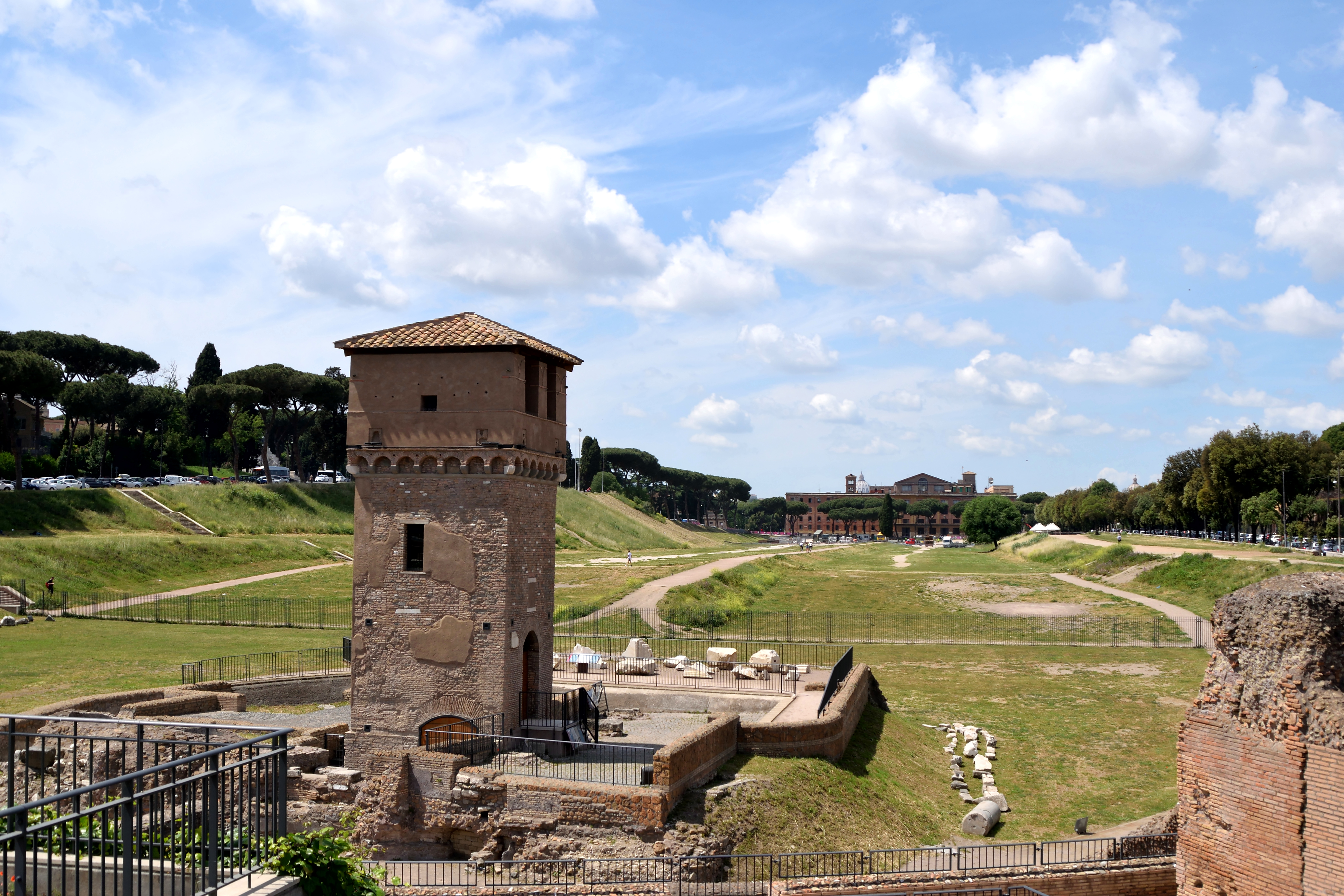|
Shrine Of Vulcan
The Shrine of Vulcan (), or Vulcanal, or Volcanal, was an 8th-century BC sacred precinct on the future site of the Roman Forum in Rome, modern Italy. Dedicated to Vulcan, the Roman god of fire, it was traditionally considered to commemorate the spot where the legendary figures Romulus and Tatius concluded the peace treaty between the tribes known as the Latins — on the Palatine Hill — and the Sabines — on the Quirinal and Esquiline. This famous merger of the hill-villages was said to be the foundation of the Roman state. Description The original Vulcanal was an open-air altar on the slopes of the Capitoline Hill in Rome in the area that would later become the Comitium and Roman Forum. It was located in the open here, between the hill-villages, in the days before Rome existed, because the fire god was considered to be too destructive to be located anywhere near an occupied house. (He was mainly worshiped in order to avert fires.) It contained a lotus tree and cypress ... [...More Info...] [...Related Items...] OR: [Wikipedia] [Google] [Baidu] |
Dionysius Of Halicarnassus
Dionysius of Halicarnassus (, ; – after 7 BC) was a Greek historian and teacher of rhetoric, who flourished during the reign of Emperor Augustus. His literary style was ''atticistic'' – imitating Classical Attic Greek in its prime. He is known for his work ''Rhōmaikē Archaiologia'' (Roman Antiquities), which describes the history of Rome from its beginnings until the outbreak of the First Punic War in 264 BC. Out of twenty books, only the first nine have survived. Dionysius' opinion of the necessity of a promotion of paideia within education, from true knowledge of classical sources, endured for centuries in a form integral to the identity of the Greek elite. Life He was a Halicarnassian. At some time after the end of the civil wars he moved to Rome, and spent twenty-two years studying Latin and literature and preparing materials for his history. During this period, he gave lessons in rhetoric, and enjoyed the society of many distinguished men. The date of his d ... [...More Info...] [...Related Items...] OR: [Wikipedia] [Google] [Baidu] |
Augustus
Gaius Julius Caesar Augustus (born Gaius Octavius; 23 September 63 BC – 19 August AD 14), also known as Octavian (), was the founder of the Roman Empire, who reigned as the first Roman emperor from 27 BC until his death in AD 14. The reign of Augustus initiated an Roman imperial cult, imperial cult and an era of regional hegemony, imperial peace (the or ) in which the Roman world was largely free of armed conflict. The Principate system of government was established during his reign and lasted until the Crisis of the Third Century. Octavian was born into an equites, equestrian branch of the plebeian Octavia gens, Octavia. Following his maternal great-uncle Julius Caesar's assassination of Julius Caesar, assassination in 44 BC, Octavian was named in Caesar's will as his Adoption in ancient Rome, adopted son and heir, and inherited Caesar's name, estate, and the loyalty of his legions. He, Mark Antony, and Marcus Lepidus formed the Second Triumvirat ... [...More Info...] [...Related Items...] OR: [Wikipedia] [Google] [Baidu] |
Roman Monarchy
The Roman Kingdom, also known as the Roman monarchy and the regal period of ancient Rome, was the earliest period of Roman history when the city and its territory were ruled by kings. According to tradition, the Roman Kingdom began with the city's founding , with settlements around the Palatine Hill along the river Tiber in central Italy, and ended with the overthrow of the kings and the establishment of the Republic . Little is certain about the kingdom's history as no records and few inscriptions from the time of the kings have survived. The accounts of this period written during the Republic and the Empire are thought largely to be based on oral tradition. Origin The site of the founding of the Roman Kingdom (and eventual Republic and Empire) included a ford where one could cross the river Tiber in central Italy. The Palatine Hill and hills surrounding it provided easily defensible positions in the wide fertile plain surrounding them. Each of these features contribut ... [...More Info...] [...Related Items...] OR: [Wikipedia] [Google] [Baidu] |
Christian Hülsen
Christian Karl Friedrich Hülsen (born in Charlottenburg, 29 November 1858; died in Florence, Italy, on 19 January 1935) was a German architectural historian of the classical era who later changed to studying the Middle Ages and the Renaissance. Biography Hülsen was born in Berlin. He studied classical philology, ancient history and archaeology with Ernst Curtius, Johann Gustav Droysen (1808-1884), Emil Hübner (1834-1901), Johannes Vahlen (1830-1911), and Theodor Mommsen (1817-1903). His dissertation, on Ovid, was directed by Mommsen and Hübner. Through Mommsen, he was awarded a stipend from the DAI ( Deutsches Archäologisches Institut) to travel to Rome where he assisted in the compilation of the ''Corpus Inscriptionum Latinarum'' for the city of Rome. In 1904 he published his ''Das Forum Romanum'', an important and widely translated work on the Roman Forum. As a topographical scholar he gained equal fame with his volume on Roman topography, volume three of ''Topographie d ... [...More Info...] [...Related Items...] OR: [Wikipedia] [Google] [Baidu] |
Temple Of Concord
The Temple of Concord () in the ancient city of Rome refers to a series of shrines or temples dedicated to the Roman goddess Concordia, and erected at the western end of the Roman Forum. The earliest temple is believed to have been vowed by Marcus Furius Camillus in 367 BC, but it may not have been built until 218 BC by L. Manlius. The temple was rebuilt in 121 BC, and again by the future emperor Tiberius between 7 BC and AD 10. History One tradition ascribes the first Temple of Concord to a vow made by Camillus in 367 BC, on the occasion of the ''Lex Licinia Sextia'', the law passed by the tribunes Gaius Licinius Stolo and Lucius Sextius Lateranus, opening the consulship to the plebeians. The two had prevented the election of any magistrates for a period of several years, as part of the conflict of the orders. Nominated dictator to face an invasion of the Gauls, Camillus, encouraged by his fellow patrician Marcus Fabius Ambustus, Stolo's father-in-law, determined ... [...More Info...] [...Related Items...] OR: [Wikipedia] [Google] [Baidu] |
Circus Maximus
The Circus Maximus (Latin for "largest circus"; Italian language, Italian: ''Circo Massimo'') is an ancient Roman chariot racing, chariot-racing stadium and mass entertainment venue in Rome, Italy. In the valley between the Aventine Hill, Aventine and Palatine Hill, Palatine hills, it was the first and largest stadium in ancient Rome and its later Roman Empire, Empire. It measured in length and in width and could accommodate over 150,000 spectators. In its fully developed form, it became the model for Circus (building), circuses throughout the Roman Empire. The site is now a public park. Events and uses The Circus was Rome's largest venue for ''ludi'', public games connected to Religion in ancient Rome, Roman religious Roman festival, festivals. ''Ludi'' were sponsored by leading Romans or the Roman state for the benefit of the SPQR, Roman people (''populus Romanus'') and List of Roman deities, gods. Most were held annually or at annual intervals on the Roman calendar. Oth ... [...More Info...] [...Related Items...] OR: [Wikipedia] [Google] [Baidu] |
Horatius Cocles
Publius Horatius Cocles was an officer in the army of the early Roman Republic who famously defended the Pons Sublicius from the invading army of Etruscan civilization, Etruscan King Lars Porsena of Clusium in the late 6th century BC, during the Roman-Etruscan Wars#War with Clusium in 508 BC, war between Rome and Clusium. By defending the narrow end of the bridge, he and his companions were able to hold off the attacking army long enough to allow other Romans to destroy the bridge behind him, blocking the Etruscans' advance and saving the city. Background Horatius was a member of the ancient patrician (ancient Rome), patrician house of the Horatia gens, Horatii, celebrated in legend since the combat between the Horatii, Horatii and the Curiatii in the time of Tullus Hostilius, the third Kings of Rome, Roman king.Dionysius of Halicarnassus, ''Romaike Archaiologia'', v. 24, 25. He was a nephew of the Roman consul, consul, Marcus Horatius Pulvillus, and is said to have obtained h ... [...More Info...] [...Related Items...] OR: [Wikipedia] [Google] [Baidu] |
Caenina (town)
Caenina was a town nearby ancient Rome, in Latium. In Rome's early semi-legendary history, the king of the Romans, Romulus, sought to obtain women as wives for his male citizens. After delegations were sent to nearby regions requesting wives and the delegations were refused, Romulus devised a festival of Neptune Equester and proclaimed the festival amongst Rome's neighbours. The citizens of Caenina (the Caeninenses) attended the festival along with many others of Rome's neighbours, including the Crustumini, and Antemnates, and many of the Sabines. At the festival Romulus gave a signal, at which the Romans grabbed the virgins amongst the spectators for wives. This event is known as The Rape of the Sabine Women. Outraged at the occurrence, the king of the Caeninenses entered upon Roman territory with his army. Romulus and the Romans met the Caeninenses in battle, killed their king, and routed their army. Romulus subsequently attacked Caenina and took it at the first assault. ... [...More Info...] [...Related Items...] OR: [Wikipedia] [Google] [Baidu] |
Quadriga
A quadriga is a car or chariot drawn by four horses abreast and favoured for chariot racing in classical antiquity and the Roman Empire. The word derives from the Latin , a contraction of , from ': four, and ': yoke. In Latin the word is almost always used in the plural and usually refers to the team of four horses rather than the chariot they pull. In Greek, a four-horse chariot was known as . The four-horse abreast arrangement in a ''quadriga'' is distinct from the more common four-in-hand array of two horses in the front plus two horses behind those. ''Quadrigae'' were raced in the Ancient Olympic Games and other contests. They are represented in profile pulling the chariot of gods and heroes on Greek vases and in bas-relief. During the festival of the Halieia, the ancient Rhodians would sacrifice a ''quadriga''-chariot by throwing it into the sea. The ''quadriga'' was adopted in ancient Roman chariot racing. ''Quadrigas'' were emblems of triumph. Victory or Fame ar ... [...More Info...] [...Related Items...] OR: [Wikipedia] [Google] [Baidu] |
Cupressus Sempervirens
''Cupressus sempervirens'', the Mediterranean cypress (also known as Italian cypress, Tuscan cypress, Persian cypress, or pencil pine), is a species of cypress native to the eastern Mediterranean region and Iran. While some studies show it has modern medicinal properties, it is most noted for uses in folk medicine, where the dried leaves of the plant are used to treat various ailments. It is well-adapted to the environmental conditions that it lives in due to its ability to survive in both acidic and alkaline soils and withstand drought. ''Cupressus sempervirens'' is widely present in culture, most notably in Iran, where it is both a sacred tree and a metaphor for "the graceful figure of the beloved". Description ''Cupressus sempervirens'' is a medium-sized coniferous evergreen tree growing up to 35 m (115 ft) tall, with a conic crown with level branches and variably loosely hanging branchlets. It is very long-lived, with some trees reported to be over 1,000 years ... [...More Info...] [...Related Items...] OR: [Wikipedia] [Google] [Baidu] |
Lotus Tree
The lotus tree (, ''lōtós'') is a plant that is referred to in stories from Greek and Roman mythology. The lotus tree is mentioned in Homer's '' Odyssey'' as bearing a fruit that caused a pleasant drowsiness, and which was said to be the only food of an island people called the Lotophagi or lotus-eaters. When they ate of the lotus tree, they would forget their friends and homes and would lose their desire to return to their native land in favor of living in idleness. Botanical candidates for the lotus tree include the persimmon ('' Diospyros lotus''), which is a sub-evergreen tree native to Southwest Asia and Southeast Europe that grows to about bearing yellowish green flowers, as well as ''Ziziphus lotus'', a plant with an edible fruit closely related to the jujube, native to the Mediterranean region of Europe, Asia and North Africa. In Ovid's '' Metamorphoses'', the nymph Lotis was the beautiful daughter of Neptune, the god of water and the sea. In order to flee the ... [...More Info...] [...Related Items...] OR: [Wikipedia] [Google] [Baidu] |








